A Blanket Purchase Agreement (BPA) is a pre-determined contract that is applied in procurement. It is an agreement that enables repetitive purchases. It does not require separate bidding every time. It deals with a particular time frame. Ordering can be made on demand. It provides terms, conditions, and prices early. BPAs decrease paperwork and time. They enhance efficiency in the purchase. This approach is suitable in situations of repeated demands. It is commonly applied to a routine supply or services. Buyers obtain flexibility. Vendors have received safe demand. BPA assists in creating relationships with suppliers in the long term. It also helps to control costs and improve planning.
What are the Key Features of a BPA?
These are the four key characteristics of a Blanket Purchase Agreement (BPA):
No Order Commitment
There is no specified number of purchases a BPA demands. It allows buyers to issue orders on a demand basis, and the buyer is not exposed to minimum or maximum quantities.
Fixed Terms & Pricing
The agreement provides fixed terms and pricing in advance. It assists in maintaining costs low and purchase consistency across the entire length of the BPA.
Simplified Ordering
It is easy to order and quick. It avoids redundant bidding, paperwork, and increases the speed of transaction and decreases paper flow to both buyers and suppliers.
Multi-User Access
The same BPA can be used by authorised departments or team members. This common access ensures that there is ease in procurement across units with central control and tracking.
What are the Steps to Establish a BPA?
Here are the 5 main steps to establish a Blanket Purchase Agreement:
Needs Assessment
Consider the repetitive buying requirements of your organisation, frequency of use and quantity. Determine the goods or services that are subject to regular purchasing operations and can be covered by a long-term contract.
Supplier Selection
Shortlist suppliers based on prices, capacity, lead time and performance record. Choose individuals who are able to perform consistently according to set conditions.
Agreement Setup
Ensure clarity in terms of pricing schedules, contract length, and contract scope of supply. Develop the BPA document to cover ordering procedures, responsibilities, and service level expectations.
Order Placement
When necessary, place release orders based on the set BPA terms. It prevents redundant bidding and creates a smooth ordering process in the case of consistent procurement.
Monitoring and Review
Monitor the suppliers in terms of compliance, time of delivery, and volumes of orders. Review the performance regularly and revise the BPA terms where necessary to achieve improved efficiency.
What are the Types of Blanket Purchase Agreements?
Here are the 2 types of Blanket Purchase Agreements:
- Single-Award BPA
- Multiple-Award BPA
Single-Award BPA
A Single-Award BPA is a pre-planned agreement with a single supplier to receive all purchases of a given product or service. It helps to create uniformity in prices, quality, and shipment conditions. This type is convenient when only one supplier can satisfy the requirements.
Multiple-Award BPA
A Multiple-Award BPA is formed with multiple suppliers who meet the needs. It enables organisations to select between vendors on the basis of current pricing, availability or performance. It is a flexible form, decreases the issue of supply risk and enhances competitive value.
What are the Common Use Cases of BPA?
Here are 4 common use cases of Blanket Purchase Agreements:
- BPAs are also commonly used to purchase office supplies such as paper, ink, and stationery to maintain a stable supply and minimise a variety of orders.
- BPAs manage facility maintenance services, such as maintenance of operations, repairs, janitorial duties, and maintenance of air conditioning systems.
- BPAs have been used to cover IT equipment and technical support to simplify purchases and hardware standardisation across departments.
- BPAs are used to organise travel services like flights, hotel bookings, and transportation to manage the budget and policy compliance.

George C. Tagg, Jr.
George serves as a trusted counsel to business leaders, non-profit executives, and management teams. George is a licensed attorney with a master’s in international affairs and over 20 years’ experience in the U.S. Congress, Department of State, Department of Defense, global public policy, and political campaigns.


